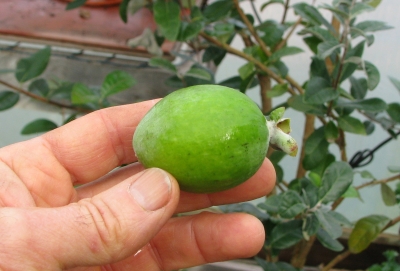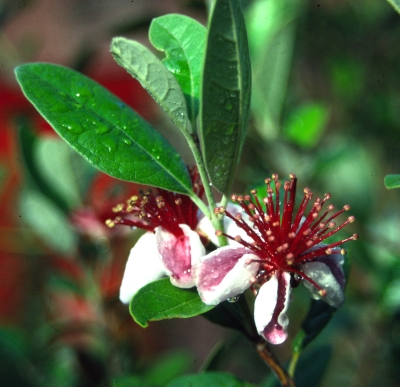FROM GROCERS’ SHELVES TO MY FLOWER POTS
Exotic, tropical fruits are turning up more and more frequently on grocers’ shelves these days: dates, papayas, guavas, and others. I look upon these fruits opportunistically, because within each lies dormant seeds that can be coaxed to become exotic, if not beautiful, indoor plants that might even provide a delicious fruit harvest. Such plants provide a break from the humdrum of spider plants, philodendrons, and Swedish ivies.
Seeds of tropical fruits usually germinate best if planted as soon as the fruits are eaten. Cold-climate fruits, in contrast, have innate inhibitors that prevent seed germination until they feel that winter is over.
So all that’s necessary to grow most tropical fruits is to wash their seeds and sow them in potting soil, using the old rule of thumb of burying a seed to twice its depth. And then wait.
DELICIOUS, BUT HARD TO SAY
I have harvested fruit grown from the seed of a grocery store bought pineapple guava, also known as the feijoa (pronounced FAY-HO’-A, from the generic part of its unwieldy Latin name, Feijoa sellowiana, recently change to Aca sellowiana). The fresh seeds, scooped from the fruit, germinated and grew.

Feijoa seems to me an ideal plant to grow. Even outdoors where it’s native, the tree is small, so does not mind being kept five foot high in a pot which can be carried indoors during our frigid winters. The plant is subtropical rather than tropical, so can stand a bit of cold, down to about 10 degrees Fahrenheit.
Feijoa has leaves which are shiny and dark green on their upper surfaces, and felt-like and silvery on their lower surfaces. My plant spends winter decorating a sunny, south-facing window in a cool room in my house. The flowers’ stamens are arranged in a tuft like a red bottlebrush, and the petals are thick, purple and white. Those petals are very edible and very delicious, with a sweet, pineapple-minty flavor.

But best of all is the fruit itself. Beneath the thin skin is a gelatinous center with a spicy pineapple flavor. My feijoa plant hasn’t provided sufficient harvest to satisfy my feijoa-ish needs.
A LONG TIME TO WAIT FOR A DATE
The waiting period for a date fruit can be a long time, even a long time for the seed to germinate. But stop for a moment and think about deserts, where dates are native. Should a date seed send up a leafy shoot with the first hint of moisture? Of course not. The dry desert air would dehydrate the sprout in short order. When a date seed germinates, first its thick taproot grows straight downwards, seeking permanent moisture, long before even a small sprout appears aboveground.
I once planted some date seeds (first making sure they came from unpasteurized dates). Knowing that I would have a long wait before the first sprouts emerged, I planned to watch the roots grow to keep myself from becoming too impatient. I put an inch of water in the bottom of a peanut butter jar, slid a tube of rolled-up blotting paper (watercolor paining paper would probably also work well) into the jar, and then “planted” the date seeds halfway up the jar, pressed between the glass and the paper.
As predicted, the roots appeared and thrust downwards before there was any sign of a shoot. When I eventually became bored watching the progress of the roots, I planted the seedlings in potting soil.
Leaves finally did poke up through the soil, an event that was far from dramatic. Each emerging seedling looked like a green toothpick stuck into the soil. In time, the “toothpicks” did unfurl into a succession of fan-like leaves which would match any ordinary houseplant for beauty and tolerance of neglect.
Fruit production from a homegrown date palm is well-nigh impossible. The plant grows slowly. Climate here in northeastern U.S. is suboptimal, to say the least. And only female plants produce fruit, so enough plants would have to be grown to flowering size to ensure at least one male (for pollination) and one female (for fruit).


Date palm orchard, Israel
PA-PA-PAPAYA
One winter day a number of years ago, I planted seeds from a papaya fruit I had just eaten. Having seen papayas growing wild throughout the tropics, I assumed they would not be hard to grow. I scooped the seeds from the fruit, washed them to remove their gelatinous coating, and sowed them immediately.
Growing papayas proved as challenging as growing dates. In this case, not only were the seeds slow to germinate, but the young seedlings were extremely fragile and subject to damping-off. I nursed a single survivor beyond this wimpy initial stage, and, in time, it began to grow robustly.

Potted papaya at Chanticleer
In the tropics, papayas are short-lived trees that often bear their first fruits as early as eleven months after seed is sown. My papaya tree was outgrowing its one-foot-diameter pot when warm weather arrived, so I decided to plant it outside and hope for fruit. Imagine the astonishment of my neighbor, who grew up in Florida, when he saw a tropical papaya tree in my garden!
Unfortunately, my plant succumbed to the first fall frost before it had a chance to fruit. Fruiting would have been chancy anyway, because papaya plants come in various combinations of sexes. Some plants have only male flowers; others only female flowers; and still others have bisexual flowers. Papaya have been known to switch their sex under certain conditions. To fruit, my single plant would have needed bisexual flowers, which remained so.
The feijoa, date palm, and the papaya take their place in the long line of avocados, prickly pears, tree tomatoes, kumquats, lemons, tangerines and other forgotten grocery store plants that once were and, in some cases, still are part of my indoor jungle.

Lemon, Kumquat, Opuntia, Tree tomato

